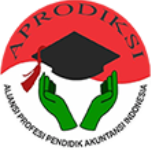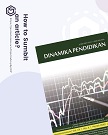Why Instrument Needs to be Revised? An Experience in Developing Digital Creativity Instrument with The Expert Judgement
(1) Universitas Sebelas Maret
(2) Universitas Sebelas Maret
(3) Universitas Sebelas Maret
Abstract
Keywords
Full Text:
PDFReferences
Aguilar, D., & Turmo, M. P. (2019). Promoting social creativity in science education with digital technology to overcome inequalities: A scoping review. Frontiers in Psychology, 10(JULY). https://doi.org/10.3389/fpsyg.2019.01474
Aiken, L. R. (1985). Three coefficients for analyzing the reliability and validity of ratings, Educational and Psychological Measurument. Journal Articles; Reports - Research; Numerical/Quantitative Data, 45(1), 131–142.
Al Hashimi, S., Al Muwali, A., Zaki, Y., & Mahdi, N. (2019). The effectiveness of social media and multimedia-based pedagogy in enhancing creativity among art, design, and digital media students. International Journal of Emerging Technologies in Learning, 14(21), 176–190. https://doi.org/10.3991/ijet.v14i21.10596
Amabile, T. M. (1982). Social psychology of creativity: A consensual assessment technique. Journal of Personality and Social Psychology, 43(5), 997–1013. https://doi.org/10.1037/0022-3514.43.5.997
Beaton, D. E., Bombardier, C., Guillemin, F., & Ferraz, M. B. (2000). Guidelines for the process of cross-cultural adaptation of self-report measures. Spine, 25(24), 3186–3191. https://doi.org/10.1097/00007632-200012150-00014
Birkey, R., & Hausserman, C. (2019). Inducing creativity in accountants’ task performance: The effects of background, environment, and feedback. Advances in Accounting Education: Teaching and Curriculum Innovations, 22, 109–133. https://doi.org/10.1108/S1085-462220190000022006
Blegur, J., Mahendra, A., Mahardika, I. M. S., Lumba, A. J. F., & Rajagukguk, C. P. M. (2023). Construction of Analytical Thinking Skills Instruments for Micro Teaching Courses. Journal of Education Research and Evaluation, 7(2), 184–196. https://doi.org/10.23887/jere.v7i2.57025
Bruno, C. (2022). Digital Creativity Dimension: A New Domain for Creativity. In C. Bruno (Ed.), Creativity in the Design Process. Springer Series in Design and Innovation (Vol. 18, pp. 29–42). Springer International Publishing. https://doi.org/10.1007/978-3-030-87258-8_3
Burbules, N. C., Fan, G., & Repp, P. (2020). Five trends of education and technology in a sustainable future. Geography and Sustainability, 1(2), 93–97. https://doi.org/10.1016/j.geosus.2020.05.001
Canina, M. R., & Bruno, C. (2021). Design and creativity for developing digital maturity skills. International Conference on Engineering and Product Design Education 9-10 September 2021, Via Design, Via University College, Herning, Denmark, September.
Chang, Y. S., & Yu, K. C. (2015). The relationship between perceptions of an innovative environment and creative performance in an online synchronous environment. Computers in Human Behavior, 49, 38–43. https://doi.org/10.1016/j.chb.2015.02.040
Chen, Y., Liu, M., & Cheng, Y. (2023). Discovering Scientific Creativity with Digital Storytelling. Journal of Creativity, 33(1), 100041. https://doi.org/10.1016/j.yjoc.2022.100041
Cicchetti, D., Bronen, R., Spencer, S., Haut, S., Berg, A., Oliver, P., & Tyrer, P. (2006). Rating scales, scales of measurement, issues of reliability: Resolving some critical issues for clinicians and researchers. Journal of Nervous and Mental Disease, 194(8), 557–564. https://doi.org/10.1097/01.nmd.0000230392.83607.c5
Cropley, D., & Cropley, A. (2008). Elements of a Universal Aesthetic of Creativity. Psychology of Aesthetics, Creativity, and the Arts, 2(3), 155–161. https://doi.org/10.1037/1931-3896.2.3.155
Digital Creativity for Developing Digital Maturity Future. (2017). Guidelines & toolkit digital creativity for developing digital maturity skill. https://www.dc4dm.eu/
Ediyanto, E., Sunandar, A., Ramadhani, R. S., & Aqilah, T. S. (2022). Sustainable Instrument Development in Educational Research. Discourse and Communication for Sustainable Education, 13(1), 37–47. https://doi.org/10.2478/dcse-2022-0004
Grigorenko, E. L. (2019). Creativity in digital reality. Studies in Psychology, 40(3), 585–607. https://doi.org/https://doi.org/10.1080/02109395.2019.1660122
Guan, J. Q., Wang, L. H., Chen, Q., Jin, K., & Hwang, G. J. (2021). Effects of a virtual reality-based pottery making approach on junior high school students’ creativity and learning engagement. Interactive Learning Environments, 0(0), 1–17. https://doi.org/10.1080/10494820.2021.1871631
Haller, C. S., Courvoisier, D. S., & Cropley, D. H. (2011). Perhaps there is accounting for taste: Evaluating the creativity of products. Creativity Research Journal, 23(2), 99–109. https://doi.org/10.1080/10400419.2011.571182
Hoffmann, J., Ivcevic, Z., & Brackett, M. (2016). Creativity in the Age of Technology: Measuring the Digital Creativity of Millennials. Creativity Research Journal, 28(2), 149–153. https://doi.org/10.1080/10400419.2016.1162515
Holisah, H., Atikah, C., & Rusdiyani, I. (2023). Development of Capcut Application in Natural and Social Science Learning for Elementary School. Scaffolding: Jurnal …, 5(2), 271–292. https://doi.org/10.37680/scaffolding.v5i2.2870
Janse van Rensburg, C., Coetzee, S. A., & Schmulian, A. (2022). Developing digital creativity through authentic assessment. Assessment and Evaluation in Higher Education, 47(6), 857–877. https://doi.org/10.1080/02602938.2021.1968791
Kao, M. C., Yuan, Y. H., & Wang, Y. X. (2023). The study on designed gamified mobile learning model to assess students’ learning outcome of accounting education. Heliyon, 9(2), e13409. https://doi.org/10.1016/j.heliyon.2023.e13409
Kaplan, D. E. (2019). Creativity in Education: Teaching for Creativity Development. Psychology, 10(02), 140–147. https://doi.org/10.4236/psych.2019.102012
Kim, K. H. (2011). The Creativity Crisis: The Decrease in Creative Thinking Scores on the Torrance Tests of Creative Thinking. Creativity Research Journal, 23(4), 285–295. https://doi.org/10.1080/10400419.2011.627805
Kotsiou, A., Fajardo-Tovar, D. D., Cowhitt, T., Major, L., & Wegerif, R. (2022). A scoping review of Future Skills frameworks. Irish Educational Studies, 41(1), 171–186. https://doi.org/10.1080/03323315.2021.2022522
Lawson, R. A., Blocher, E. J., Brewer, P. C., Cokins, G., Sorensen, J. E., Stout, D. E., Sundem, G. L., Wolcott, S. K., & Wouters, M. J. F. (2014). Focusing accounting curricula on students’ long-run careers: Recommendations for an integrated competency-based framework for accounting education. Issues in Accounting Education, 29(2), 295–317. https://doi.org/10.2308/iace-50673
Lee, M. R., & Chen, T. T. (2015). Digital creativity: Research themes and framework. Computers in Human Behavior, 42, 12–19. https://doi.org/10.1016/j.chb.2014.04.001
Matitu, B., & Santiago, R. (2023). Ways forward in the teaching of Physical Education: The private and public university experiences. Bedan Research Journal, 8(1), 81–109. https://doi.org/10.58870/berj.v8i1.48
Morrow Jr, J. R., Mood, D., Disch, J., & Kang, M. (2015). Measurement and evaluation in human performance, , 5E. Human Kinetics.
Pahmi, L. D., & Syafwin, M. (2022). Using the Capcut Application as A Learning Media. Journal International Inspire Education Technology, 1(April), 40–51. http://download.garuda.kemdikbud.go.id/article.php?article=2938429&val=25956&title=Using the Capcut Application as A Learning Media
Pathways Commission. (2015). Pathways Commission: In Pursuit of Accounting Curricula of the Future. In American Accounting Association (Issue November). https://aaahq.org/Portals/0/images/education/Pathways/15-9-61866.pdf?ver=2021-02-23- 175219
Pinho, K. (2015). Deloitte to launch career education program at cornerstone schools. Accessed on 5 March 2021.
Powell, L., Lambert, D., McGuigan, N., Prasad, A., & Lin, J. (2020). Fostering creativity in audit through co-created role-play. Accounting Education, 29(6), 605–639. https://doi.org/10.1080/09639284.2020.1838929
Puccio, G. (2017). Creativity: A Skill to Cultivate In the 21st Century.
Ratnasari, L. T., Mariatun, I. L., & Arief, Z. (2022). Development of instagram-based learning media to increase learning motivation of tenth grader in econmics subjects at SMA Ar-raudhah. Journal of Educational Science, 6(3), 332–340. https://doi.org/10.31258/jes.6.3.p.332-340
Reffien, M. A. M., Ismail, A., Sulong, S., Bahanuddin, T. P. Z. T., Salleh, N. M., & Nasir, N. H. (2022). Development, validity and reliability of instrument to evaluate implementation fidelity of the Family Doctor Concept (FDC) programme in public primary care clinics in Malaysia. Malaysian Family Physician, 17(1), 20–28. https://doi.org/10.51866/oa1197
Ricard, M., Zachariou, A., & Burgos, D. (2020). Digital Education, Information and Communication Technology, and Education for Sustainable Development BT - Radical Solutions and eLearning: Practical Innovations and Online Educational Technology (D. Burgos (ed.); pp. 27–39). Springer Singapore. https://doi.org/10.1007/978-981-15-4952-6_2
Roebianto, A., Savitri, S. I., Aulia, I., Suciyana, A., & Mubarokah, L. (2023). Content Validity: Definition and Procedure of Content Validation in Psychological Research. TPM - Testing, Psychometrics, Methodology in Applied Psychology, 30(1), 5–18. https://doi.org/10.4473/TPM30.1.1
Sánchez-Holgado, P., & Arcila-Calderón, C. (2017). Adoption of media by European scientists for the creation of scientific transmedia storytelling. ACM International Conference Proceeding Series, Part F1322. https://doi.org/10.1145/3144826.3145451
Saprudin, S., Liliasari, S., Prihatmanto, A. S., & Setiawan, A. (2019). Profile of pre-service physics teachers’ creative thinking skills on wave and optics course. Journal of Physics: Conference Series, 1157(3). https://doi.org/10.1088/1742-6596/1157/3/032030
Şener, N., Türk, C., & Taş, E. (2015). Improving Science Attitude and Creative Thinking through Science Education Project: A Design, Implementation and Assessment. Journal of Education and Training Studies, 3(4), 57–67. https://doi.org/10.11114/jets.v3i4.771
Septiana, Y., Widayati, A., Wibawa, E. A., & Hakim, A. R. (2023). Teacher Profesionalism in Facilitating Students to Have 21st Century Skills. Dinamika Pendidikan, 18(1), 88–95. https://doi.org/10.15294/dp.v18i1.44543
Setyandari, A., Wibowo, M. E., Purwanto, E., & Sunawan. (2019). Adaptation of Academic Psychological Capital Questionnaire in Bahasa Indonesia. 443(Iset 2019), 261–264. https://doi.org/10.2991/assehr.k.200620.051
Shao, Z., Li, X., & Wang, Q. (2022). From ambidextrous learning to digital creativity: An integrative theoretical framework. Information Systems Journal, 32(3), 544–572. https://doi.org/10.1111/isj.12361
Sotille, M. (2016). Expert Judgement. [Online] Project Management. https://www.projectmanagement.com/wikis/344587/Expert-judgement
Suhana, A., & Purwadi, R. E. (2023). Video projrct assignment in English for specific purpose (ESP): The students’ perception. Eltin Journal: Journal of English Language Teaching in Indonesia, 11(2), 99–108.
Suki, N. M., & Suki, N. M. (2017). The International Journal of Determining students ’ behavioural intention to use animation and storytelling applying the UTAUT model : The moderating roles of gender and experience level. The International Journal of Management Education, 15(3), 528–538. https://doi.org/10.1016/j.ijme.2017.10.002
Syamsuddin, N. B., Tahir, H., Hermansyah, S., Sidenreng, M., & Rappang, S. (2023). Influence of the CapCut Application on the ICT Learning. 3(4), 300–307.
Tang, C., Mao, S., Naumann, S. E., & Xing, Z. (2022). Improving student creativity through digital technology products: A literature review. Thinking Skills and Creativity, 44. https://doi.org/10.1016/j.tsc.2022.101032
Taylor, M., Marrone, M., Tayar, M., & Mueller, B. (2018). Digital storytelling and visual metaphor in lectures: a study of student engagement. Accounting Education, 27(6), 552–569. https://doi.org/10.1080/09639284.2017.1361848
Torrance, E. P. (1979). The search for satory & creativity. Creative Education Foundation.
Ulfah, A. A., Kartono, K., & Susilaningsih, E. (2020). Validity of Content and Reliability of Inter-Rater Instruments Assessing Ability of Problem Solving. Journal of Educational Research and Evaluation, 9(1), 1–7. https://doi.org/10.15294/jere.v9i1.40423
Venkatesh, V., Morris, M. G., Davis, G. B., & Davis, F. D. (2003). User Acceptence of Information Technology: Toward a Unified View. MIS Quarterly, 27(3), 425–478.
Vergara-Barberán, M., Lerma-García, M. J., Herrero-Martínez, J. M., Simó-Alfonso, E. F., Beneito-Cambra, M., & Carrasco-Correa, E. J. (2023). Nanolearning: Tiktok microvideos as a new learning source. 15th International Conference on Education and New Learning Technologies, 3975–3983. https://doi.org/10.21125/edulearn.2023.1071
World Economic Forum. (2020). The future of jobs report 2020. In The Future of Jobs Report (Issue October). https://www.weforum.org/reports/the-future-of-jobs-report-2020/digest
Wulandari, A. (2023). Video Editing Application As Learning Media on Students’ Character Education in Madrasah Tsanawiyah. Jurnal Visi Ilmu Pendidikan, 15(1), 93. https://doi.org/10.26418/jvip.v15i1.55460
Yang, Y. C., Chen, Y., & Hung, H. (2020). Digital storytelling as an interdisciplinary project to improve students ’ English speaking and creative thinking. Computer Assisted Language Learning, 0(0), 1–23. https://doi.org/10.1080/09588221.2020.1750431
Zahidi, S. (2020). The Jobs of Tomorrow. In World Economic Forum. https://doi.org/10.1002/j.2164-5892.1939.tb00511.x
Refbacks
- There are currently no refbacks.

This work is licensed under a Creative Commons Attribution 4.0 International License.


.png)

.png)





